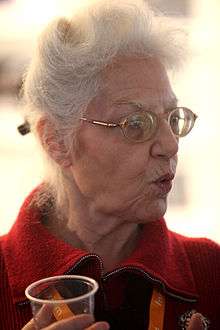Andrée Ehresmann
Andrée Ehresmann (born Andrée Bastiani, 1935)[1] is a French mathematician specialising in category theory.[2] A researcher at CNRS from 1957 to 1963, she was awarded a Ph.D. in 1962 under Gustave Choquet. She is an Emeritus Professor at IRCAM,[3] at the University of Picardie Jules Verne, having worked there from 1967.
Andrée Ehresmann | |
|---|---|
 Andrée Ehresmann in December 2010 | |
| Born | July 9, 1935 |
| Occupation | Mathematical researcher |
Ehresmann has published over a hundred works on Analysis (Differential Calculus and Infinite Dimension Distributions, Guiding Systems and Optimization Problems), Category Theory (with her husband, Charles Ehresmann: sketches and internal categories, multiple categories, closed monoidal structures) and the modeling of complex autonomous systems (Memory Scalable Systems, including the MENS model for neuro-cognitive systems)..
She developed, with J.-P. Vanbremeersch a model of Memory Evolutive Systems, which proposes a mathematical model for 'living' systems with a hierarchy of complex components with multiple temporalities, such as biological, neuro-cognitive, or social systems. Based on a theory of 'dynamic' categories, evolving memory systems can analyze complexity, emergence and self-organization. She is the director of the mathematical journal Cahiers de Topologie et Géométrie Différentielle Catégoriques.[4]
Notes and references
- Birth year from French national library catalogue listing, retrieved 2018-11-27.
- "Ehresmann, Andrée (1935...)". catalogue.bnf.fr (in French). Retrieved 28 February 2018.
- Ferri, Massimo (6 May 2015). "Ircam, Parigi: un tuffo nella matemusica" [IRCAM, Paris: a dive into mathematics]. Il Fatto Quotidiano (in Italian). Archived from the original on 2015-05-09. Retrieved 28 February 2018.
- "cahiers de topologie et géométrie différentielle catégoriques". Retrieved 2019-07-28.
External links